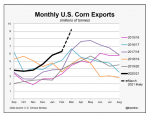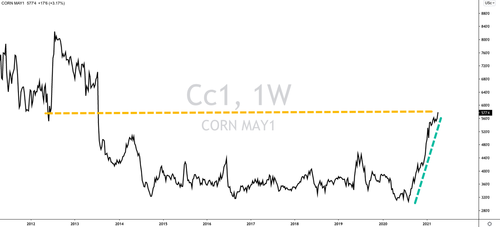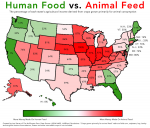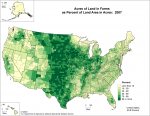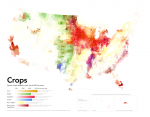Part 3
Yeager: So Ted, I need to get into a weather story. I'll lead you further down the discussion here, Ted. Boyce in Montpelier, North Dakota where we know it's dry in the state, with the drought in the north and soybeans presumably stealing acres from wheat could spring wheat surprise us and end up being the big market story this summer?
Seifried: Hey, Boyce. Yes. Well, there could be a lot of big market stories this summer potentially. But yeah, spring wheat, talking to my guys in the Dakotas they're having a really hard time getting planted. It's so dry, cold, windy, going from super hot to super cold. It has not been good. So if that spring wheat doesn't get in, in a timely fashion, like really pretty soon there's going to be thoughts of moving that over to row crops and I think you are going to see about a million acres shift, maybe not that much, but a significant amount of acres shift over to row crops. So yeah, there's a lot of wheat in the world. There's a lot of, the winter wheat you don’t really have a tight situation there but spring wheat could lead the whole wheat complex higher and I really like the chart on the spring wheat right now. I think there is quite a bit more upside unless there is a very dramatic change in the weather pattern in short order.
Yeager: Well, Kansas City, the July futures opened nearly a gap higher earlier this week. You had Kansas City I believe set a contract high. So, Matt, is there one of these contracts that is going to be a brighter star or duller performer?
Bennett: Well, in my opinion it's about got to be spring wheat. Are you going to be led by winter wheat whenever we just found out last week we had 2.6 million more acres than maybe what we thought we were going to have? And so I've got to think it's going to be spring wheat. And this isn't usually the time of year where the wheat market is leading the pack. And so it spells good things for me in the grand scheme of things. Are we going to see support for the wheat market from both corn and beans? I don't know that you would get a ton of support. But if the wheat market is rallying sharply as far as spring wheat is concerned absolutely, I think that it's a good thing for everything. A rising tide lifts all boats.
Yeager: Naomi, the livestock side of this equation, is that playing into this at all about a feed issue that corn got so expensive that wheat has now come to the day?
Blohm: We have been talking about that for a couple of months that that possibility would be coming down the road. So wheat has a lot of different moving parts to it right now. The USDA on the report today actually said that we would maybe not be using as much wheat for feed this coming year. Back to the spring wheat, the last time we were together in January I said that's the market that is going to be the one to watch and I was bullish about it back then because of all of these moving parts that are starting to come into play. Spring wheat definitely the leader. I think what you're going to see is traders doing spreads between buying the spring wheat, selling the Chicago wheat, as a way to get long the wheat. So the wheat is still the follower in the grains but the spring wheat has the ability to become the leader of the pack.
Yeager: Don, am I using wheat, if I'm a corn farmer, maybe I'm one of them that still has grain in the bin, am I paying attention closer to the old crop price of corn right now? Or am I paying a little closer attention to wheat on signals on when I should sell?
Roose: Well, it's the wrong time of the year to be bullish on wheat. Now, maybe spring wheat because of the dry drought condition in the north, that's possible. But the corn market I think you really have to watch these markets. The basis usually tells the truth. And the basis is pretty tight right now, staying tight in spreads. So I would watch those two signals as your real key. And by the way, we did have a key reversal in May corn today and we do have a big premium the May over the July, so when you look at moving out to the next month you're moving to a discount. So is this going to be the tightest point that we have between now and the first of May?
Bennett: We had a reversal last week as well though after the planting intentions. And so I agree with you, any time you see a reversal in the market you've got to pay close attention. But then we picked up quite a bit of ground on corn again this week. And so I agree with Don, you've got to watch the basis, you've got to watch the spreads, and there's no question that some originators all over the country actually are very nervous. You hear about not only really good basis levels but paying overs over the posted bid. And so there's no question in my mind that corn is going to be pretty good ownership for the time being. But, as a producer you've got to ask yourself whenever you're two dollars plus over last fall's price do you want to be bullish? At what point does greed take hold of you? You've got to be careful to get too greedy here.
Seifried: You also had a reversal in that May/July corn spread today too. So, look, a reversal doesn't necessarily mean a high. But when you start seeing a series of reversals these are all red flags that hey, we might be coming to a near-term top for now. And the volatility that we saw this week, at the end of last week and this week, that is also sort of indicative of the possibility of a near-term high. So guys need to be looking at that really very closely. It's also the right time of year for me with a good looking planting forecast to say okay, we can take a step back here. And personally I'd love to see that because that would open a whole lot of reownership opportunities for me.
Blohm: Yeah, and then how about also with the May conversation that we're having, May and July, the fact that maybe funds are going to start to exit out of any long May and start rolling into the July because we're getting closer to first notice day too. So it may not be just indicative of a bigger correction just like you were saying but there's just a lot of little simpler moving parts underneath as well. And loving how the basis throughout the Midwest continues to get strong and stronger. We had 280 on plants reopening for ethanol this week, in the middle of this high prices that they're reopening these ethanol plants I think that really says something about their optimism going forward. So that's exciting to see.
Yeager: I was going to ask you a December question but instead I'll ask you this. I'll ask kind of the same thing I did to Don. Would you be selling -- how much longer are you holding old crop corn right now?
Blohm: Oh, just trickling it along and make sales.
Yeager: You're still holding some but making --
Blohm: Keep making sales every time this market is making moves.
Yeager: Are you anxious, any of you, to pull trigger on December right now?
Seifried: I've been suggesting 30% to 50% on December. Again, if we get a bigger correction, you look for reownership strategies, as Don was saying earlier there's a lot of risk and there's a lot of risk premium that has been built into the market. There's also a lot of risk that things change, demand destruction, things like that, that could make the market go down and I think you need to be managing that risk by making these sales. I'd love to see guys close to 50% sold on new crop corn at this point.
Roose: Well, and I think you have to remember just a year ago the market was on its knees. So if you don't think things can change and change fast they can. So when you're at price risk management levels that make sense you should at least be looking at some percentage of sales.
Yeager: Well, Matt, the soybean market, one of those that was at our knees a year ago, even six months ago, was a struggling one. It is in the shadow of everything right now. Ted kind of alluded a little bit that he sees a story coming. Do you see a story coming, a bullish picture coming? We've been stuck near $14 for about three weeks now.
Bennett: Yeah, we've just been kind of flailing along here, not really doing a whole lot. Just in my opinion on beans, whenever you look at how tight the situation is it's hard to get super bearish. But at the same time as a producer, you run the numbers on cash beans, how do you get bullish at $14? Now, I'm not saying as a trader you can't. But as a producer if I'm looking at new crop soybean prices whispering on $13 here lately, we're above $12.50, I'll tell you what, you can put a floor under the market significantly above any sales that you've made for quite some time and let the upside run if you want to. But I kind of like selling a few beans and buy a short-dated call if you want. But I want to stay flexible because I think you could see major fireworks this summer with any hint of a weather issue.
Yeager: Uh-oh, fireworks, did you just get excited?
Blohm: We need at least 90 million acres of soybeans to plant if not more, like you were saying earlier. So we're not going to know that data until the end of June of course. But that keeps the market overall supported between now and the end of June. And so it's just really exciting for producers. But you're right, don't lose sight of the value in front of you because it's amazing value but there is potential for upside if the stars continue to align.
Roose: And November soybeans you're talking from a producer level are trading about 40 cents higher than July '22. So from a producer are you going to carry beans for eight months and lose 40 cents? I don't think so. So when you hit the fall timeframe there's going to be a merchandising challenge for a lot of people.
Seifried: Paul, I've been saying since the beginning of the year and we've been doing this that November beans are the most undervalued contract on the board, on the grains board. I still think that's the case. You look at what is happening for next year if we don't get 90 million acres, which it would be unprecedented to go from an 87 to 90, if we don't get 90 million acres, if we don't have a 52 or 53 national average yield, given the demand outlook it looks like we're going to be wildly negative soybeans on our balance sheet for next year. Now, not saying that demand is necessarily going to be there. I would really like to see some new crop soybean export sales on the books. We were off to a good start but then we really flattened out, saw a little bit last week, I'd like to see more. But if we don't have a reason to think that demand is going to get destroyed we are really set up for a very interesting scenario for new crop beans.
Bennett: I agree. And here's the thing I'll say. Whenever you look, it's going to be hard to get those acres, first of all. Second of all though, if you look at the yields possible where the beans are being planted are actually in high yielding states if you look at the planting intentions. And so there is a possibility that we could look at a very large national yield. But at the same time on the record, I'll tell you what, I think that Dec corn and November beans are actually something that both could rally just a little bit based upon this acreage situation. We have to get more acres if we're going to make both balance sheets look really good.
Yeager: Naomi, I've got to have you answer this question. Are beans losing acres to cotton because of cotton's performance over the last three months, six months?
Blohm: Cotton is saying don't forget about me, that's what cotton is saying. We have that brilliant rally, that four, five month rally and then a setback recently. Today's report was supported. They increased the exports for cotton, which they should have because sales were at 104% so they needed to reflect that on the report today. So with cotton prices showing a little excitement, we hit a recent low, starting to build back higher, yeah it's definitely saying don't forget about me. So cotton is definitely back in this conversation and I think we still have spring wheat in the conversation along with the other markets. So it is an exciting time for agriculture, that's for sure.
Yeager: Don, there's a saying about the cattle market right now, there's optimism that beef demand is phenomenal. But the question is where will reality and optimism meet in the cattle market?
Roose: Well, what has happened right now is you've got a grain premium you're kicking in. Look at next year's April cattle got up to $133. But really it's about the demand market. The demand is so strong. That is really what is pushing us to the upside. Packer margins are huge, $600 a head. But where are we going to go from here? Seasonally we usually start to top out right now. So are we going to do it normal seasonal? Today the government put out projections. They're like $120 for the fourth quarter and for the summer they're like $115 to $117 so we've got a lot of premium in the market but it's a grain premium and you actually need it on the meat market at the present time.
Yeager Matt, the feeder we talked about it a little bit trying to figure out is there something else you feed with. But if you're a backgrounder right now feeding cattle are you worried?
Bennett: I'd say I'd be a little bit worried. The thing is if you buy feeders right now and then you look at feed and then you look at fats on out to the fourth quarter into February it's pretty thin. So you've got to be cautious. What is a cattle producer going to do? He's going to step out on a limb and go out on faith and that is something that they have always done. You've got to be really cautious though and I don't want to go out here and just hedge cattle and not do anything about my feed costs because quite frankly if this summer doesn't turn out to be a good weather pattern your feed costs could soar through the roof. So you've got to be really cautious there.
Yeager: Ted, a hog came to shore in Taiwan this week, tested positive for African swine fever, thought to have come from China. What is that doing to the world hog market? Is it impacting the global or the U.S. market more?
Seifried: The U.S. market is hoping that we're going to see a fair amount of exports to Southeast Asia, China in particular, late spring, summer months. You look at where August hogs are trading, it's really pretty impressive. Exports have been pretty good even without China. China was on but barely on, didn't make a big splash on this last week's export sales report. But it was still a really solid number. Domestic demand is really good. Cutout values are on fire. There's reason why hogs continue to make new contract highs. It's a really good looking chart. I think there's more upside potential for hogs.
Yeager: Is there, Don?
Roose: Well, I tell you, I look at it a little bit different. As the U.S. market is going up the rest of the world is going down. China, their hog prices are under our hog prices. They're down 37% since a year, we were down 10% this week on hogs. Our exports were poor down 10% over a year ago in February. So I'd be pretty leery of the hog market. It's solid now on disease and demand but keep an eye on it.
Yeager: Naomi, is the dairy market solid right now?
Blohm: It is a really nice time in the dairy markets, prices have been on an upswing in part because the global dairy trade auction has been higher nine out of the last ten sessions. Our actual cheese prices are lower than global prices right now so that is strong. Whey prices are improving, they're at the highest level since 2014. And with grain prices improving that is also lifting the milk prices. So we've got front month milk contracts mid-$19 level, which in and of itself without that extra farm to family food program were seeing this marketplace do its own thing. Production levels are up but starting to decline. And so going forward depending on how the feed situation is this summer we might see more production declines if the quality isn't there. I know that where I live in Wisconsin we are, it's going to be tricky sourcing soybeans. So it is a friendly market for the dairy.
Yeager: That's Naomi Blohm. Thank you so very much, Naomi. Ted Seifried is here. Don Roose is here. Matthew Bennett. Thank you all. Time flies when you're having fun but we're just getting started. That will do it for the TV side. We're going to do a web thing called Market Plus here in just a moment so join us there. Find that on our website of MarkettoMarket.org. Now, a reminder, it is spring fieldwork season. Duh. But that doesn't mean that you have an excuse for missing our weekly analysis, the Market Plus or the MtoM podcast. All are able to go where you go. Subscribe to all three and take us along for the ride. Remember, we do like cab time as well. Next week we take a look at new weapons that are helping pollinators in the fight against colony collapse disorder. Thank you so much for watching. Have a great week.
Trading in futures and options involves substantial risk. No warranty is given or implied by Iowa PBS or the analysts who appear on Market to Market. Past performance is not necessarily indicative of future results.
Market to Market is a production of Iowa PBS which is solely responsible for its content.


